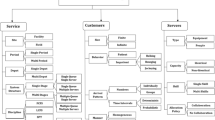Abstract
The problem of scheduling under timeliness (optimal completion time) constraint is considered. This investigation is motivated by the emergence of Time Value Function based scheduling approaches in recent real-time operating systems. Each task is characterized by processing duration, optimal completion time and weight coefficient. A sub-optimal polynomial algorithm is proposed, which performs sequence setting, optimal and suboptimal decomposition and the error upper bound computation. This algorithm is easy to implement and requires few computation and memory resources. Simulations show that this algorithm yields optimal and nearly optimal sequences for many scenarios.
Similar content being viewed by others
References
BaggaP.C., and KalraK.R. 1980. A Node Elimination Procedure for Towsend's Algorithm for Solving the Single Machine Quadratic Penalty Function Scheduling Problem. Manag. Science, 26, (6): 633–636.
ConwayR.W., MaxwellW.L., and MillerL.W. 1967. Theory of scheduling. Reading, MA: Addison-Wesley.
CoffmanE.G.Jr. 1976. Computer and Job-Shop Scheduling Theory. New York: Wiley and Sons.
GareyM.R., and JohnsonD.S. 1979. Computers and Intractability: A Guide to the Theory of NP-Completeness. New York: Freeman.
GuptaS.K., and SenT. 1984. On the Single Machine Scheduling Problem with Quadratic Penalty Function of Completion Times: An Improved Branching Procedure. Manag. Science, 30, (5): 644–647.
HeldM. and KarpR.M. 1962. A Dynamic Programming Approach to Sequencing Problems. J. SIAM, 10, (1): 196–210.
Jensen, E.D., Locke, C.D. and Tokuda, H. 1985. A Time-driven scheduling Model for Real-Time Operating System. IEEE Real-Time Symposium, pp: 112–122.
KnuthD.E. 1969. The Art of Computer Programming, Volume One: Fundamental Algorithms. Reading, MA: Addison-Wesley.
Le Lann, G. 1990. Critical issues for the development of distributed real-time computing systems. INRIA Research Report RR-1274.
LiuC.L., and LaylandJ.W. 1973. Scheduling Algorithms for Multiprogramming in a Hard-Real-Time Environment. J. ACM, 20, (1): 46–61.
LawlerE.L., and MooreJ.M. 1969. A Functional Equation and its Application to Resource Allocation and Sequencing Problems. Manag. Science, 16, (1): 77–84.
Northcutt, J.D. 1988. The Alpha Operating System: Requirements and Rationale. Archons Project Tech. Rep. No. 88011.
PosnerM.E. 1988. The deadline constrained completion time problem: analysis of a heuristic. Oper. Res; 36, (5): 742–746.
SahniS. 1976. Algorithm for Scheduling Independent Tasks. J. ACM, 23, (1): 116–127.
SahniS., and ChoY-K. 1979. Nearly on line scheduling for a uniform processor system with release times. SIAM J. Comp., 8: 275–285.
SzwarcW., PosnerM.E., and LiuJ. 1989. The Single Machine Problem with a Quadratic Cost Function of Completion Time. Manag. Science, 34, (12): 1480–1488.
SpruntB., ShaL. and LehoczkyJ. 1989. Aperiodic Task Scheduling for Hard-Real-Time Systems. J. Real-time Syst., 1: 27–60.
StankovicJ.A. 1988. Misconceptions about Real-Time Computing, A Serious Problem for Next-generation Systems. IEEE Computer, 21(10): 10–19.
TownsendW. 1978. The Single Machine Problem with Quadratic Penalty Function of Completion Times: A Branchand-Bound Solution. Manag. Science, 24, (5): 530–534.
Tokuda, H., Wendor, J.W., and Wang, H-Y. 1987. Implementation of a Time-driven Scheduler for Real-Time Operating Systems. IEEE Real-Time Symposium, pp: 271–280.
WeissH.J. 1981. A Greedy Heuristic for Single Machine Sequencing with Precedence Constraints. Manag. Science, 27, (10): 1209–1216.
Wendor, J.W. 1988. Implementation and Evaluation of a Time-driven Scheduling Processor. IEEE Real-Time Symposium, pp: 172–180.
ZhaoW., RamamrithamK., and StankovicJ.A. 1987. Preemptive Scheduling Under Time and Resource Constraints. IEEE Trans. Computer, 36, (8): 949–960.
Author information
Authors and Affiliations
Additional information
This work was done when the author was with the REFLECS/MEVAL Projects of INRIA, France. This work was supported by a Post-doc scholarship of INRIA.
Rights and permissions
About this article
Cite this article
Chen, K. A study on the timeliness property in real-time systems. Real-Time Syst 3, 247–273 (1991). https://doi.org/10.1007/BF00364958
Issue Date:
DOI: https://doi.org/10.1007/BF00364958




